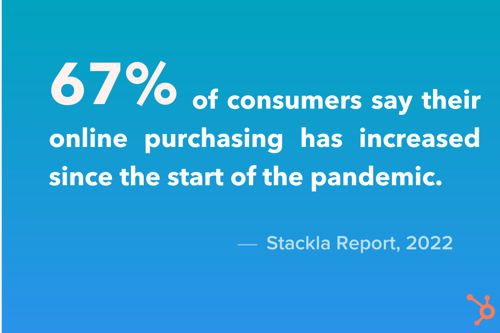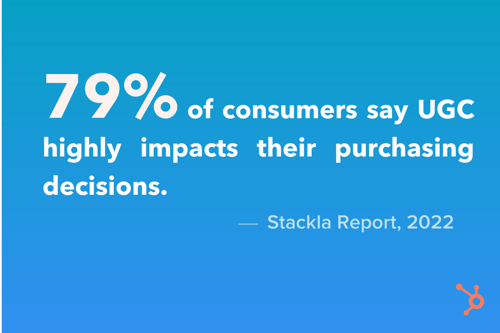Just because we're marketers doesn't mean we really know the science behind what drives consumers to purchase. But marketing without that information is like walking outside with a blindfold on – it's going to be very hard to end up at your destination without a scratch.
Below, we’ll cover some data sets on buyer behavior, their key findings, and the lessons you should take away from each piece of research.
So let's dive right in.
Statistics on the Growth of Online Shopping
According to Statista, online shoppers have increased from 209 million in 2016 to 230 million in 2021.
While technological advances were already shifting how consumers approached shopping, the onset of the pandemic in 2020 aided this shift event more.
In fact, a Stackla report found that 67% of consumers say their online purchasing has increased since the start of the pandemic – 27% said it increased considerably.

With social media platforms offering advanced shopping features, it’s no wonder shoppers are buying more online. On Instagram, you can discover a brand, sift through its products, and complete a purchase without ever leaving the app.
This frictionless shopping experience helps contribute to a consumer base that shops exclusively online.
A Jungle Scout survey found that 46% of consumers only buy holiday gifts online.
So, what does this mean for brands? This forces brands that focused more on offline campaigns to shift gears and redirect their attention to online consumers.
This data isn’t suggesting that you should now change your business model to an online-first approach. However, to stay relevant and competitive, building a strong digital presence is key.
What Drives Online Shoppers
One of the biggest questions marketers have surrounding online shopping is what gets the consumer to finally click that “Buy” button. The answer is complicated because it varies based on the audience, the industry, the product, and many other factors.
However, there are some universal elements that definitely help steer consumers toward purchase.
The first is personalization. According to the Stackla report, 72% of people say they are more likely to purchase from a brand if it consistently provides them with a more personalized experience.
Personally, any brand email I receive that includes my name gets more attention than the ones that don’t. Why? It catches my attention and makes the email feel more intimate – even though I know it was likely automated.
Another big driver is user-generated content. We know that social proof can be incredibly effective in creating buzz surrounding a brand.
In the same report, 79% of people say UGC highly impacts their purchasing decisions, considerably more than branded content and influencer content.

Another form of social proof? Reviews.
58% of consumers have left an ecommerce store without purchasing because the site didn’t contain any customer reviews or photos.
Images can be incredibly impactful when someone is considering a purchase. In fact, most consumers surveyed in the Stackla report say they’re more influenced by social media images and videos than they were before the pandemic.
A long-term play that drives purchases is building community.
According to the report, 61% of consumers would be more loyal and more likely to buy from a brand if they were invited to be part of a customer advocate community or content creators.
When you build a community with your audience, they feel more connected to your brand and thus, more likely to purchase and spread the word.
Millennials Online Shopping Statistics
When it comes to Millennials specifically, here are some interesting stats about their online shopping behaviors.
- 60% of Millennials have left an eCommerce store without purchasing because the site didn’t have customer reviews or photos. (Stackla report, 2021)
- Millennials spending power is $2.5 trillion. (Ypulse, 2020)
- 30% of Millennials used buy-now-pay-later services (BNPL) in 2021 and 39.5% are forecasted to use them in 2023. (Statista, 2021)
- Roughly 40% of Millennials say that they have started a new relationship (or strengthened an existing one) with businesses that prioritize the environment. (Deloitte, 2020)
from Marketing https://blog.hubspot.com/marketing/online-buyer-behavior-data
Just because we're marketers doesn't mean we really know the science behind what drives consumers to purchase. But marketing without that information is like walking outside with a blindfold on – it's going to be very hard to end up at your destination without a scratch.
Below, we’ll cover some data sets on buyer behavior, their key findings, and the lessons you should take away from each piece of research.
So let's dive right in.
Statistics on the Growth of Online Shopping
According to Statista, online shoppers have increased from 209 million in 2016 to 230 million in 2021.
While technological advances were already shifting how consumers approached shopping, the onset of the pandemic in 2020 aided this shift event more.
In fact, a Stackla report found that 67% of consumers say their online purchasing has increased since the start of the pandemic – 27% said it increased considerably.

With social media platforms offering advanced shopping features, it’s no wonder shoppers are buying more online. On Instagram, you can discover a brand, sift through its products, and complete a purchase without ever leaving the app.
This frictionless shopping experience helps contribute to a consumer base that shops exclusively online.
A Jungle Scout survey found that 46% of consumers only buy holiday gifts online.
So, what does this mean for brands? This forces brands that focused more on offline campaigns to shift gears and redirect their attention to online consumers.
This data isn’t suggesting that you should now change your business model to an online-first approach. However, to stay relevant and competitive, building a strong digital presence is key.
What Drives Online Shoppers
One of the biggest questions marketers have surrounding online shopping is what gets the consumer to finally click that “Buy” button. The answer is complicated because it varies based on the audience, the industry, the product, and many other factors.
However, there are some universal elements that definitely help steer consumers toward purchase.
The first is personalization. According to the Stackla report, 72% of people say they are more likely to purchase from a brand if it consistently provides them with a more personalized experience.
Personally, any brand email I receive that includes my name gets more attention than the ones that don’t. Why? It catches my attention and makes the email feel more intimate – even though I know it was likely automated.
Another big driver is user-generated content. We know that social proof can be incredibly effective in creating buzz surrounding a brand.
In the same report, 79% of people say UGC highly impacts their purchasing decisions, considerably more than branded content and influencer content.

Another form of social proof? Reviews.
58% of consumers have left an ecommerce store without purchasing because the site didn’t contain any customer reviews or photos.
Images can be incredibly impactful when someone is considering a purchase. In fact, most consumers surveyed in the Stackla report say they’re more influenced by social media images and videos than they were before the pandemic.
A long-term play that drives purchases is building community.
According to the report, 61% of consumers would be more loyal and more likely to buy from a brand if they were invited to be part of a customer advocate community or content creators.
When you build a community with your audience, they feel more connected to your brand and thus, more likely to purchase and spread the word.
Millennials Online Shopping Statistics
When it comes to Millennials specifically, here are some interesting stats about their online shopping behaviors.
- 60% of Millennials have left an eCommerce store without purchasing because the site didn’t have customer reviews or photos. (Stackla report, 2021)
- Millennials spending power is $2.5 trillion. (Ypulse, 2020)
- 30% of Millennials used buy-now-pay-later services (BNPL) in 2021 and 39.5% are forecasted to use them in 2023. (Statista, 2021)
- Roughly 40% of Millennials say that they have started a new relationship (or strengthened an existing one) with businesses that prioritize the environment. (Deloitte, 2020)


No hay comentarios:
Publicar un comentario